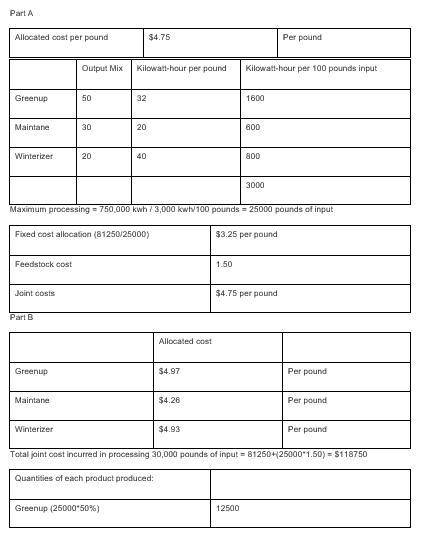
Business, 15.04.2020 03:20, sharpeyennifer
Ag-Coop is a large farm cooperative with a number of agriculture-related manufacturing and service divisions. As a cooperative, it pays no federal income taxes. The company owns a fertilizer plant that processes and mixes petrochemical compounds into three brands of agricultural fertilizer: Greenup, Maintane, and Winterizer. The three brands differ with respect to selling price and the proportional content of basic chemicals.
The Fertilizer Manufacturing Division transfers the completed product to the cooperative’s Retail Sales Division at a price based on the cost of each type of fertilizer plus a markup. The Manufacturing Division is completely automated so that the only costs it incurs are for the petrochemical inputs plus automated conversion, which is committed for the coming period. The primary feedstock costs $1.50 per kilogram.
Each 1,000 kilograms of feedstock can produce either of the following mixtures of fertilizer:
Output Schedules (in kilograms) A B
Greenup 500 600
Maintane 300 100
Winterizer 200 300
Production is limited to the monthly capacity of the dehydrator at 750,000 kilowatt-hours. The different chemical makeup of each brand of fertilizer requires different dehydrator use as follows:
Product Kilowatt-Hour
Usage per Kilogram
Greenup 32
Maintane 20
Winterizer 40
Monthly conversion costs are $81,250. The company is producing according to output schedule A. Joint-production costs including conversion are allocated to each product on the basis of weight.
The fertilizer is packed into 50-kilogram bags for sale in the cooperative’s retail stores. The Manufacturing Division charges the retail stores its cost plus a markup. The sales price for each product charged by the cooperative’s Retail Sales Division is as follows:
Sales Price per Kilogram
Greenup $10.50
Maintane 9.00
Winterizer 10.40
Selling expenses are 20 percent of the sales price.
The manager of the Retail Sales Division has complained that the prices charged are excessive and that she would prefer to purchase from another supplier. The Manufacturing Division manager argues that the processing mix was determined based on a careful analysis of the costs of each product compared to the prices charged by the Retail Sales Division.
Required:
a. Assume that joint-production costs including conversion are allocated to each product on the basis of weight. What is the cost per kilogram of each product including conversion costs and the feedstock cost of $1.50 per kilogram, given the current production schedule?
b. Assume that joint-production costs including conversion are allocated to each product on the basis of net realizable value if it is sold through the cooperative’s Retail Sales Division. What is the allocated cost per kilogram of each product, given the current production schedule?
c. Assume that joint-production costs including conversion are allocated to each product on the basis of weight. Which of the two production schedules, A or B, produces the higher operating profit to the rm as a whole?
d. Would your answer to requirement (c) be different if joint-production costs including committed overhead were allocated to each product on the basis of net realizable value? Explain.
e. Can you recommend an approach to product planning that considers the organization’s overall profitability and avoids the divisional controversy? What are the costs and benefits of your recommended approach?

Answers: 2
Other questions on the subject: Business

Business, 21.06.2019 23:00, joannegrace869
Which of the following statements is correct? a. two firms with identical sales and operating costs but with different amounts of debt and tax rates will have different operating incomes by definition. b. free cash flow (fcf) is, essentially, the cash flow that is available for interest and dividends after the company has made the investments in current and fixed assets that are necessary to sustain ongoing operations. c. retained earnings as reported on the balance sheet represent cash and, therefore, are available to distribute to stockholders as dividends or any other required cash payments to creditors and suppliers. d. if a firm is reporting its income in accordance with generally accepted accounting principles, then its net income as reported on the income statement should be equal to its free cash flow. e. after-tax operating income is calculated as ebit(1 - t) + depreciation.
Answers: 2

Business, 22.06.2019 09:50, anonymous777739
Beck company had the following accounts and balances at the end of the year. what is net income or net loss for the year? cash $ 74 comma 000 accounts payable $12,000 common stock $21,000 dividends $12,000 operating expenses $ 13 comma 000 accounts receivable $ 49 comma 000 inventory $ 47 comma 000 longminusterm notes payable $33,000 revenues $ 91 comma 000 salaries payable $ 30 comma 000
Answers: 1

Business, 22.06.2019 17:00, allofthosefruit
Jillian wants to plan her finances because she wants to create and maintain her tax and credit history. she also wants to chart out all of her financial transactions for the past federal fiscal year. what duration should jillian consider to calculate her finances? from (march or january )to (december or april)?
Answers: 1

Business, 22.06.2019 20:00, HahaHELPP
In william rathje's garbology project that focused on household waste, front door interviews found 15 percent of respondents saying that they consumed beer. the trash discard from the same area showed what percentage of household's consuming beer
Answers: 1
Do you know the correct answer?
Ag-Coop is a large farm cooperative with a number of agriculture-related manufacturing and service d...
Questions in other subjects:


Biology, 21.06.2019 15:00

History, 21.06.2019 15:00

History, 21.06.2019 15:00


Mathematics, 21.06.2019 15:00

Mathematics, 21.06.2019 15:00


Mathematics, 21.06.2019 15:00

History, 21.06.2019 15:00









